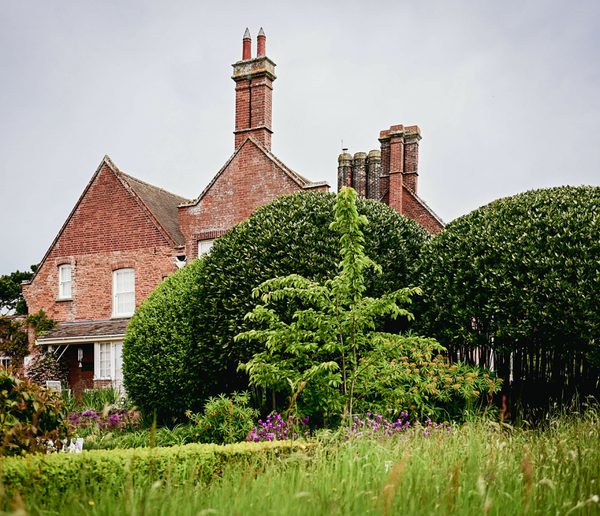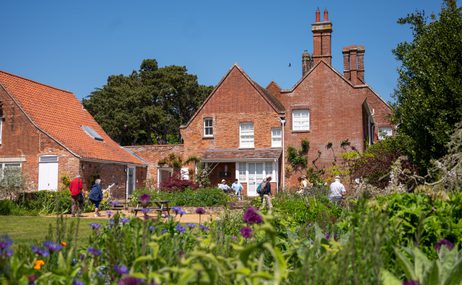A conversation with Joe Carr, Collection and Learning Curator at The Red House. Joe aims to bring education and enrichment to people by engaging them with music and the resources at The Red House. From hosting Mini Music Makers to creating resources for schools to contributing to Participate sessions, he is involved in a wide array of the organisation's charitable work.
So Joe, what do you do?
My job title is collection and learning curator - based at The Red House but part of the community team. In a nutshell my job is using The Red House, its collections, its stories, and work by Benjamin Britten to engage and reach out to schools, families and young people through a variety of different events and activities.
What is the average week like for you?
A really good thing about the job is that it's really, really varied. Every week is not the same at all. I might be delivering sessions in schools; we have a lot of different sessions that we deliver in schools, or schools come to The Red House on day trips. I might be working to develop new ideas for school visits and sessions. I manage any activities at The Red House and Snape Maltings which engage families, such as half term or holiday activities. Every Friday I’m working with under fives running our Mini Music Makers sessions and developing sessions for those. I could be doing projects in schools such as art award projects, I manage all our arts award offer, which is a qualification in the arts for young people. We’ve got different school partners we work with during the week, so I might be with those.
I also help to manage the collections at The Red House, I make sure we have proper ways to document the objects and conserve them. So, it’s really varied - no week is the same which makes it quite fun.

A Mini Music Makers session.
What is the best part about your job?
I would say the best part is working with all the different community groups and young people and really using our collections, music and stories to engage and communicate with our communities, which helps in many ways to improve their lives.
All the work with the community team is amazing, reaching all the groups that we do and really helping them through music. I especially enjoy the work we do with children, families and schools as well, so I think they’re the most rewarding and seeing how music, history and stories can really change and spark curiosity is amazing.
What has been the highlight or most rewarding part of your career?
My background is in museums and heritage, so I’ve worked in a lot of different museums, for about 20 years. I helped develop Time and Tide Museum, which was a great project to be a part of. I’ve worked at Brent Museum in London, which is the most culturally diverse kind of borough in London, working with loads of different community groups to try and engage them with history and heritage. Also West Stow Anglo Saxon Museum, I managed all the learning and developed our learning programme, and we had 200 children visiting every day.
But at Britten Pears Arts there have been a lot of highlights. Developing our school programme at The Red House is a big one because we have gone from not many schools visiting to about 3000 children visiting every year for a range of different activities. Being recognised for our family work has been great; last year we won Suffolk Museum Family Friendly Award.
One of the most rewarding projects has been working with special schools. We did a project over the last few years working with the charity Autism and Nature, and three special schools, developing opportunities for them to come and engage with The Red House. That was a really rewarding project.
Another thing is setting us up as an Art Award Centre. Since we started there have been about 300 children successfully complete an art award through Britten Pears Arts which is amazing. It’s a qualification, something they can use in their future, which is great. We’re continuing this through lots of local schools, so this is something I am proud of as well.
What inspires you?
I am really inspired by the impact that our work has had for the different groups that we work with. From really local families who find it hard to reach out and engage with the community with Mini Music Makers, to Participate groups and working with people who have dementia. Seeing the impact that music, history and our sites can make really inspires me to keep doing it.
I got a lot of inspiration from lockdown, because we continued our Mini Music Maker sessions online and we got loads of positive feedback from families saying how important that was. Things like that help to inspire me and keep me going.
What is your history and relationship with music?
My background was history. I completed a BA in History and Landscape Archeology, followed that with a PGCE and after that did an MA in Museum Studies, because I wanted to work in museums. So I’ve got a history and heritage background, but music has always been there.
My dad was a brilliant guitarist. In the 60s, he toured with lots of bands playing the guitar, such as Status Quo, and he taught me guitar from a young age. Growing up, I always played a lot of music he loved, I was the only one of my friends who knew a lot of Eric Clapton stuff, 60s and 70s rock, and Bad Company, and Cream – so guitar and playing music has always been very important to me.
In what ways do you think music is beneficial for children?
It’s a brilliant way to engage, I found that even before working here, because we all use music in some way. Even if you don’t play an instrument or sing, music is always in a child’s life. It could be exercising to music, or just listening when doing chores, music is there. It really is an amazing tool to engage children and help them learn. I’ve found that in every museum or setting I’ve worked in.
What is it like working at The Red House?
The Red House is an amazing site. Not only is there the history of it being Benjamin Britten’s former home, the history goes back to the 17th century when it was a farm, there is so many stories around that. The collections are really rich and varied, there’s an amazing fine art collection which people don’t realise as well as the collection about Benjamin Britten, and the social history collections. There’s so many elements of history and music to reach so many people in different ways. So it’s a really good site to do that kind of thing as well as a beautiful location.

The Red House, Aldeburgh
What did it mean to achieve Museum Accreditation status at The Red House?
The Museum Accreditation is the Art Council standards that museums need to meet. It shows they have good practice and can be trusted. When I started at The Red House, one of the main aims was to get us the accreditation status. It’s been a long process, I think I started it up around 2018 and it just shows how as a team we really are committed towards good museum practice in terms of looking after objects, collections and sharing those stories. It will really help with future projects going forward.
What are you looking forward to in the future?
Continuing our strong relationships with communities, I can see us having a much stronger relationship with schools throughout our partnership programmes we’re developing as well as all of our other offers for schools. We want stronger relationships with local schools too, we’ve seen that already with our relationship with Snape primary which has really developed this year. I’m looking forward to more work with special schools, more SEN projects and building on the work we’ve done. And a lot more working with local families and giving them more ways to engage with both sites in different ways. I think it’s pretty exciting, there’s a lot of fun things coming up.

